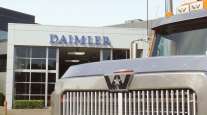Senior Reporter
Daimler Posts Income Increase, Revenue Dip in Q4

[Stay on top of transportation news: Get TTNews in your inbox.]
Daimler AG reported a dip in revenue and a gain in net income in the fourth quarter compared with a net loss a year earlier.
Additionally, the company recently announced plans to rename itself Mercedes-Benz and the truck and bus unit would become Daimler Truck AG. Like the truck unit, the car business would be individually traded.
At the same time, Daimler Truck AG appointed John O’Leary as the next president and CEO of Daimler Trucks North America, the leading truck maker in North America, effective April 1.

O'Leary
For the quarter ended Dec. 31, Daimler (reporting in euros) had the equivalent net income of $4.2 billion, or $4.09 per diluted share, compared with a net loss of $13 million, loss of 12 cents, in the 2019 period.
“Our financial results significantly exceeded expectations in 2020, due in particular to a strong fourth quarter,” said Daimler Chairman Ola Källenius.
The company noted unit sales of its Mercedes-Benz cars in China, its largest market for the luxury cars, set a record.
Free cash flow climbed to $5.6 billion, up 151% compared with $2.1 billion a year earlier. Free cash flow is the remaining cash after a company pays its operating expenses and capital expenditures.
Revenue in the quarter slipped 1% to $56.2 billion compared with $56.8 billion a year earlier, according to the Stuttgart, Germany-based company.
“Across all our divisions, we made significant progress with efficiency in 2020. We will continue along this path with the same discipline. The pandemic has once again made it clear that efficiency is a prerequisite for the ability to act effectively,” Källenius wrote in a letter to investors.
Today, we’re reporting our business figures for 2020. Our financial results for the last year were significantly better than expected, and we’re looking ahead confidently to 2021 if current market conditions prevail. #Daimler $DDAIF — Daimler AG (@Daimler) February 18, 2021
Spending on research and development in the quarter fell 23% to $2.1 billion compared with $2.9 billion a year earlier.
“Our high development expenditures on new technologies in areas such as electric drive systems, autonomous driving and digitalization can only be kept as low as possible per vehicle if we develop our innovations on the basis of universal platforms and utilize them in as many markets and vehicles as possible,” the company wrote in its annual report.
During the year it announced partnerships with Waymo (for Level 4 autonomous trucks), Volvo Trucks (for fuel cells) and Proterra (for battery-electric vehicles).
Earnings before interest and taxes at its Mercedes-Benz cars and vans segment, its largest, increased to $4.3 billion compared with $74 million a year earlier. The unit’s return on sales was 12% compared with 0.2%.
Truck and bus unit EBIT climbed 10% to $595 million compared with $539 million in the 2019 period. The unit’s return on sales rose to 4.7% compared with 4% a year earlier.

Mergers and acquisitions have reshaped the trucking technology sector over the past decade, but what does this trend mean for the trucking and logistics companies that rely on these technologies? Seth Clevenger speaks with James Langley of Trimble Transportation. Hear a snippet, above, and get the full program by going to RoadSigns.TTNews.com.
Its mobility business posted EBIT of $705 million compared with $105 million a year earlier. Its return on equity was 16.2% compared with 2.4% a year earlier.
Revenue for the Daimler mobility unit fell 3% to $8.6 billion.
New leasing and financing offers coming from the mobility unit will “explicitly” serve to promote the sale of electric vehicles at its divisions, the company reported.
Meanwhile, unit sales of vehicles in the quarter were lower.
At Mercedes-Benz, its largest unit, sales were down 1% to 641,146 vehicles. Vans slipped 8% to 119,749 compared with a year earlier.
Revenue for Mercedes-Benz vans and buses was off 1% at $37 billion.
Truck sales in the quarter fell 6% to 113,795 compared with 120,745 a year earlier.
Revenue for the trucks and buses unit dropped 6% to $12.5 billion.
Daimler’s U.S. brands are Freightliner and Western Star. Freightliner sells in Classes 4-8, while Western Star makes a heavy-duty truck.
The company intends to offer production series trucks and buses with battery-electric drive systems in Europe, the United States and Japan by 2022. In the second half of the 2020s, Daimler Trucks & Buses intends to offer series-produced fuel cell-powered electric trucks.
In order to increase its profitability on a lasting basis, the company reported it intends to exploit the potential of its service business in a more targeted manner. To this end, it is expanding its existing range of after-sales products and creating new services. One example of this is the introduction of 3D printing for spare parts at Daimler Buses.
Looking further ahead, the truck and bus unit intends to offer only new vehicles that are C02-neutral, tank-to-wheel, in Europe, Japan and North America by 2039.
For the full year, net income rose to $4.8 billion, $4.09, compared with $3.2 billion, $2.68, a year earlier. Revenue was $186.2 billion compared with $208.5 billion a year earlier.
Want more news? Listen to today's daily briefing below or go here for more info:




